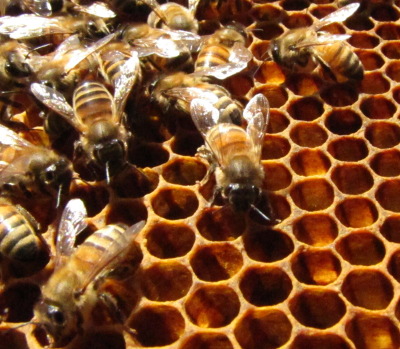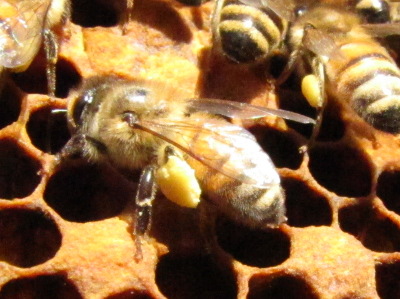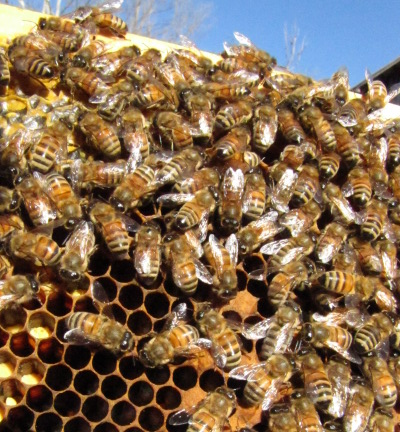
One hive remains
 I
took advantage of a warm, sunny afternoon to
dip into the hives. As I suspected, the second weak
hive
was dead. I hadn't been entirely sure because our strong hive
found both empty hives so quickly that there were always bees coming in
and out, carrying honey home to their own colony. The robbing is
a good sign, since most people report that bees won't steal honey from
a colony collapse disorder hive --- more data to support my hypothesis
that my dead hives were due to excessive and sudden cold snaps combined
with (perhaps) too high varroa mite numbers.
I
took advantage of a warm, sunny afternoon to
dip into the hives. As I suspected, the second weak
hive
was dead. I hadn't been entirely sure because our strong hive
found both empty hives so quickly that there were always bees coming in
and out, carrying honey home to their own colony. The robbing is
a good sign, since most people report that bees won't steal honey from
a colony collapse disorder hive --- more data to support my hypothesis
that my dead hives were due to excessive and sudden cold snaps combined
with (perhaps) too high varroa mite numbers.
 Inside the living hive, parts
of
two frames were already full of brood
in all stages of development (maybe a third of a frame of brood
total.) Since this hive is our only hope at the moment, I
lavished them with honey and pollen, moving a full brood box from the
other hives on top of their half-full brood box so that the colony will
have plenty
to eat. Not
that they need it --- they're already carting home wild pollen.
But I figure I might as well save them the trouble of flying over to
the
neighboring hive to steal the abandoned honey.
Inside the living hive, parts
of
two frames were already full of brood
in all stages of development (maybe a third of a frame of brood
total.) Since this hive is our only hope at the moment, I
lavished them with honey and pollen, moving a full brood box from the
other hives on top of their half-full brood box so that the colony will
have plenty
to eat. Not
that they need it --- they're already carting home wild pollen.
But I figure I might as well save them the trouble of flying over to
the
neighboring hive to steal the abandoned honey.
 Now it's just a waiting
game. How soon will the hive be so full
of brood that I can split
it in half? I
saw the first dandelion
flower this week, which is a cue that spring has advanced far enough
to install new package bees, and I hope our bees also consider that
brilliant yellow orb a sign that they should have a baby boom.
Now it's just a waiting
game. How soon will the hive be so full
of brood that I can split
it in half? I
saw the first dandelion
flower this week, which is a cue that spring has advanced far enough
to install new package bees, and I hope our bees also consider that
brilliant yellow orb a sign that they should have a baby boom.
I'm tempted to say that
the farm feels empty with just one hive of bees, but the truth is that
those workers are ubiquitous. In the last week, I've seen them
out at the worm bin, inside at the forsythia I'm forcing on the kitchen
table (left the window cracked on a warm day --- oops!), and buzzing
around me as I worked in the garden. Our honeybees are never out
of sight, out of mind.
Want more in-depth information? Browse through our books.
Or explore more posts by date or by subject.
About us: Anna Hess and Mark Hamilton spent over a decade living self-sufficiently in the mountains of Virginia before moving north to start over from scratch in the foothills of Ohio. They've experimented with permaculture, no-till gardening, trailersteading, home-based microbusinesses and much more, writing about their adventures in both blogs and books.
Want to be notified when new comments are posted on this page? Click on the RSS button after you add a comment to subscribe to the comment feed, or simply check the box beside "email replies to me" while writing your comment.

Because the Germans have a word for everything! This refers to the honeybees' natural ability to regulate and maintain ideal temperature, relative humidity, and a natural "sauna" of anti-microbial propolis and essential pheromones within the hive that we distrupt everytime we open it to move things around. Langstroth hives don't kill bees, but the pathogens and pests that they promote and harbor do. Langstroths kill nestduftwärmebindung - Too much dead space around frames for a small, weakened colony to keep warm, too many little crevices to harbor hive beetles, too easy for a keeper to move things around. The bees know what they're doing and would succeed brilliantly if we'd only let them and stop frustrating their efforts.
Over the last couple of weekends I've built new hives based on the plans and writings of Johann Thür and Emile Warré, and a lot of inspiration from the Japanese beekeeper who goes by the handle 'mituro36' at YouTube. I've combined all of the best (ie simplest) concepts into three hives that use spales, rather than top bars, to support comb; Warré's quilt and roof; and both Thür's relative internal box dimensions (2x2x1) and Warré's (3x3x2) and adapted those dimensions for use with commonly available lumber rather than ripping boards to precise measurements on a table saw (Thür's dimensions favor a pair of 10ft 2x6's, Warré's favor the same in 2x8's). Plus, I've added some of my own modifications that incorporate a mesh floor and a rear-access drawer as an interim solid floor and for placing sticky papers. Each hive comes out to cost a little less than $30 a piece to build.
Also, because of these types of hive's considerably smaller footprint, I'm designing a few bait boxes with removeable floors and covers that can be placed directly and left on top of the awaiting hive, like any other super, should a feral swarm move into them while they're in the field - only mariginally simpler and easier than transferring frames.
Here're some links:
http://warrebeek.com/thhive.html
http://www.warrebeek.com/hive.html
http://www.users.callnetuk.com/~heaf/thur.pdf
http://www.users.callnetuk.com/~heaf/beekeeping_for_all.pdf
I'll have to post some pictures when they're complete. Hopefully, this is the solution to the hidden detriment of the Langstroth hive. Chin up! This is merely Nature's way of letting us know that we're doing something wrong.
~Dean